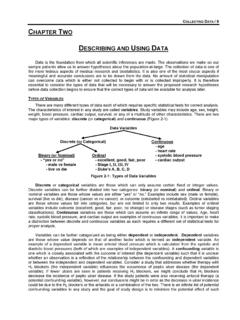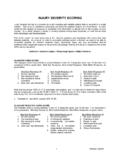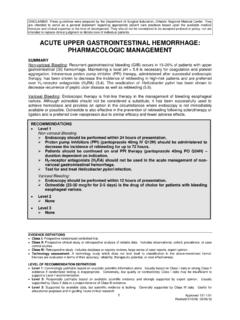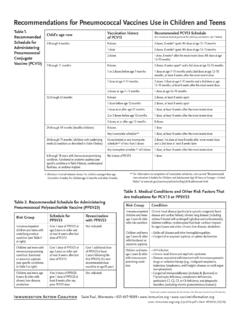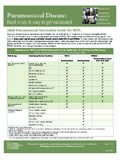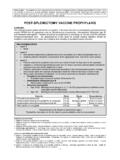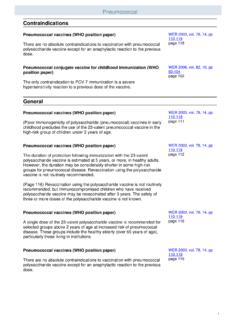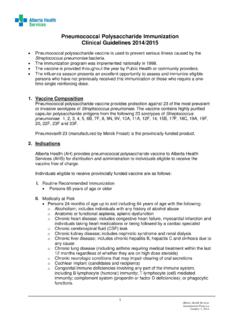Transcription of POST-SPLENECTOMY VACCINE PROPHYLAXIS
1 DISCLAIMER: These guidelines were prepared by the Department of Surgical Education, Orlando Regional Medical Center. They are intended to serve as a general statement regarding appropriate patient care practices based upon the available medical literature and clinical expertise at the time of development. They should not be considered to be accepted protocol or policy, nor are intended to replace clinical judgment or dictate care of individual patients. EVIDENCE DEFINITIONS Class I: Prospective randomized controlled trial. Class II: Prospective clinical study or retrospective analysis of reliable data. Includes observational, cohort, prevalence, or case control studies. Class III: Retrospective study. Includes database or registry reviews, large series of case reports, expert opinion. Technology assessment: A technology study which does not lend itself to classification in the above-mentioned format.
2 Devices are evaluated in terms of their accuracy, reliability, therapeutic potential, or cost effectiveness. LEVEL OF RECOMMENDATION DEFINITIONS Level 1: Convincingly justifiable based on available scientific information alone. Usually based on Class I data or strong Class II evidence if randomized testing is inappropriate. Conversely, low quality or contradictory Class I data may be insufficient to support a Level I recommendation. Level 2: Reasonably justifiable based on available scientific evidence and strongly supported by expert opinion. Usually supported by Class II data or a preponderance of Class III evidence. Level 3: Supported by available data, but scientific evidence is lacking. Generally supported by Class III data. Useful for educational purposes and in guiding future clinical research.
3 1 Approved 1/7/03 Revised 10/17/06, 11/1/11, 7/29/15 POST-SPLENECTOMY VACCINE PROPHYLAXIS SUMMARY The splenectomized patient should be vaccinated to decrease the risk of overwhelming POST-SPLENECTOMY sepsis (OPSS) by organisms such as Streptococcus pneumoniae, Haemophilus influenzae type B, and Neisseria meningitidis. Patients should be educated prior to discharge on the risk of OPSS and their immunocompromised state. An understanding of the need for prompt medical attention should be instilled in such patients to reduce the morbidity and mortality of POST-SPLENECTOMY infection. RECOMMENDATIONS Level 1 None Level 2 Non-elective splenectomy patients should be vaccinated at least 14 days POST-SPLENECTOMY or at time of discharge from the hospital. Asplenic patients should be revaccinated at the appropriate time interval for each VACCINE .
4 Level 3 Elective splenectomy patients should be vaccinated at least 14 days prior to the operation. Asplenic or immunocompromised patients (with an intact but nonfunctional spleen) should be vaccinated as soon as the diagnosis is made. When adult vaccination is indicated, the following FIVE vaccinations should be administered: o Pneumococcal VACCINE na ve: Conjugate pneumococcal VACCINE (PCV13) followed by polyvalent pneumococcal VACCINE (PPSV23) 8 weeks later o Previous PPSV23 vaccination: PCV13 1 year after PPSV23 o MenACWY (Menactra ), two doses, given at least two months apart o MenB-FHbp (three-dose series) at 0, 2, and 6 months OR MenB-04C (two dose series) at least one month apart o Haemophilus influenzae b VACCINE (HibTITER) Pediatric vaccination should be performed according to the recommended pediatric dosage and VACCINE types with special consideration made for children less than 2 years of age.
5 VACCINE Dose Route* Revaccination 13-valent pneumococcal (PCV13, Prevnar 13) mL IM None 23-valent pneumococcal (PPSV23, Pneumovax 23) mL IM or SC Once at 5 years Meningococcal/diphtheria conjugate (MenACWY, Menactra ) mL IM At 2 months and every 5 years Serogroup B meningococcal (MenB-FHbp, Trumenba ) mL IM At 2 and 6 months Serogroup B meningococcal (MenB-4C, Bexsero ) mL IM Once at 1 month Haemophilus b conjugate mL IM None 2 Approved 1/7/03 Revised 10/17/06, 11/1/11, 7/29/15 INTRODUCTION Blunt abdominal trauma commonly injures the spleen resulting in either irreparable parenchymal disruption (necessitating removal of the injured organ) or devascularization of varying degrees. Non-operative management may avoid splenectomy , but can also result in functional asplenia if the devascularization is extensive.
6 Elective splenectomy may be indicated for specific primary disease of the spleen. Loss of functional splenic tissue places such individuals at high risk for infection by encapsulated organisms such as Streptococcus pneumoniae, Haemophilus influenzae type b, and Neisseria meningitidis. Although the risk of fulminant septicemia or meningitis as a result of infection by such organisms appears to be less in the adult population (by virtue of prior exposure to these bacteria), overwhelming POST-SPLENECTOMY sepsis (OPSS) remains a significant concern in the asplenic patient (1). The incidence of OPSS is estimated to occur in to 2% of splenectomized patients (2). It may develop immediately or as late as 65 years POST-SPLENECTOMY (2-4). Mortality is significant and reported to be as high as 50% (4,5).
7 OPSS incidence reduction is dependent upon prophylactic education of the patient and physician as to its risk and prevention and rapid recognition of the asplenic individual when infection may be present (2,5-7). Reduced POST-SPLENECTOMY levels of opsonins, splenic tuftsin, and immunoglobulin (IgM) (which promote phagocytosis of particulate matter and bacteria), hinder the body s ability to clear encapsulated organisms (4,6,7). Vaccination, to impart immunity against such infections, is commonly performed despite the absence of Class I or Class II data to support its efficacy. As 50 to 90% of OPSS infections are secondary to Streptococcus pneumoniae infection, the polyvalent pneumococcal VACCINE has been the most commonly administered POST-SPLENECTOMY VACCINE . In recent years, the meningococcal and Haemophilus influenzae type b vaccines have also been advocated (2-17).
8 Timing of VACCINE administration following splenectomy has been the topic of a longstanding debate. Two major concerns include the patients immunogenicity in the perioperative period and the impaired immune function of the critically ill (2,13,16,17). The patient s present state of health should be considered prior to the administration of POST-SPLENECTOMY vaccines. In patients with moderate to severe acute illness, vaccination should be delayed until the illness has resolved. This minimizes adverse effects of the VACCINE which could be more severe in the presence of illness or could confuse the patient s clinical picture (such as a post- VACCINE fever) (16). There are two pneumococcal vaccines currently approved for use in adult patients. PPSV23 is a polyvalent VACCINE of purified capsular polysaccharides from 23 strains of Streptococcus pneumoniae (18).
9 PCV13 is composed of capsular antigen polysaccharides from 13 S. pneumoniae serotypes linked to a non-toxic diphtheria protein (19). Current Advisory Committee on Immunization Practices (ACIP) recommendations are that asplenic patients receive PCV13 during their next pneumococcal vaccination opportunity. Patients given PCV13 have demonstrated comparable or greater mean antibody titers compared to patients who received PPSV23 in two randomized, multicenter immunogenicity studies. In addition, patients who received PPSV23 prior to PCV13 had lower opsonophagocytic antibody response compared to those who received PCV13 as the initial dose (20). In light of two recent serogroup B meningococcal (MenB) disease outbreaks on college campuses in 2013, the FDA granted Breakthrough Therapy designations to two MenB vaccines, MenB-FHbp (Trumenba ) and MenB-4C (Bexsero ).
10 Both were approved for ages 10-25 years and are recommended by the ACIP for prevention of serogroup B meningococcal disesase in all asplenic patients 10 years (21). The MenB-FHbp VACCINE composed of two recombinant factor H binding proteins from N. meningitides serogroup B. It is administered as a three dose series at 0, 2, and 6 months (22). MenB-4C is composed of three recombinant proteins and outer membrane vesicles. It is administered as a two dose series given at least one month apart (23). Due to the low incidence of serogroup B meningococcal disease, the efficacy of both vaccines was evaluated in immunogenicity studies and determined based on the proportion of patients who achieved 4-fold increase in complement activity against serogroup B strains (21). 3 Approved 1/7/03 Revised 10/17/06, 11/1/11, 7/29/15 All of the vaccines can cause adverse reactions which are generally self-limiting and resolve 24-72 hours after VACCINE administration.


